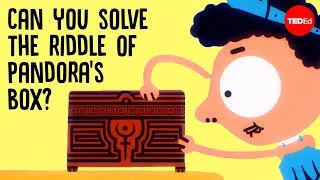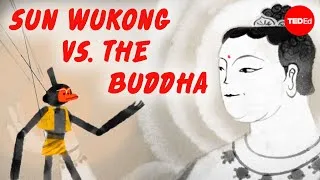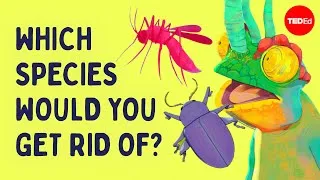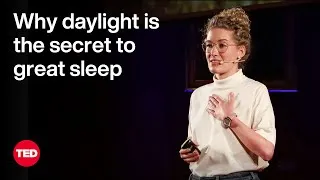請雙擊下方英文字幕播放視頻。
譯者: Lilian Chiu
審譯者: Helen Chang
00:07
Consider the classic white t-shirt.
0
7294
2689
想想經典的白 T 恤。
00:09
Annually, we sell and buy
two billion t-shirts globally,
1
9983
4211
每年,全球 T 恤
買賣的數量達 20 億件,
00:14
making it one of the most common
garments in the world.
2
14194
3289
讓它成為世界上最常見的服裝。
00:17
But how and where is the average
t-shirt made,
3
17483
3391
但一般的 T 恤是
如何和在哪裡製作的呢?
00:20
and what's its environmental impact?
4
20874
3642
它對環境的影響又是什麼?
00:24
Clothing items can vary a lot,
5
24516
1889
服飾可以有千萬種變化,
00:26
but a typical t-shirt begins its life
on a farm in America, China, or India
6
26405
5200
但就典型的 T 恤來說,它的一生
始於美國、中國,或印度的農田,
00:31
where cotton seeds are sown, irrigated and
grown for the fluffy bolls they produce.
7
31605
7296
在農田中,棉花種子經過播種、
灌溉、成長,產生出蓬鬆的圓莢。
00:38
Self-driving machines carefully harvest
these puffs,
8
38901
3839
自動駕駛的機器會仔細地採收棉球,
00:42
an industrial cotton gin mechanically
separates the fluffy bolls from the seeds,
9
42740
4685
工業用軋棉機以機械
將蓬鬆的圓莢與種子分離,
00:47
and the cotton lint is pressed
into 225-kilogram bales.
10
47425
4720
每 225 公斤的棉絨
就會被壓縮成一捆。
00:52
The cotton plants require a huge quantity
of water and pesticides.
11
52145
4712
棉花植物需要大量的水和農藥。
00:56
2,700 liters of water are needed to produce
the average t-shirt,
12
56857
4739
生產一般的 T 恤需要
用到 2,700 公升的水,
01:01
enough to fill more than 30 bathtubs.
13
61596
3570
這水量足以裝滿超過 30 個浴缸。
01:05
Meanwhile, cotton uses more insecticides
and pesticides
14
65166
3321
同時,棉花要用的殺蟲劑和農藥
01:08
than any other crop in the world.
15
68487
2920
比世界上任何作物都還要多。
01:11
These pollutants can be carcinogenic,
16
71407
2239
這些污染物可能會致癌,
01:13
harm the health of field workers,
17
73646
2244
傷害現場工人的健康,
01:15
and damage surrounding ecosystems.
18
75890
3597
破壞周圍的生態系統。
01:19
Some t-shirts are made of organic cotton
grown without pesticides and insecticides,
19
79487
4869
有些 T 恤是用有機棉製造的,
這種棉沒有農藥或殺蟲劑,
01:24
but organic cotton makes up less than 1%
20
84356
3221
但全球 2,270 萬公噸的棉產量中,
01:27
of the 22.7 million metric tons
of cotton produced worldwide.
21
87577
6370
只有不到 1% 是有機棉。
01:33
Once the cotton bales leave the farm,
22
93947
2082
一旦這些棉捆離開了農田,
01:36
textile mills ship them
to a spinning facility,
23
96029
3049
紡織廠就會將它們運送到紡紗廠,
01:39
usually in China or India,
24
99078
2611
通常都在中國或印度,
01:41
where high-tech machines blend,
25
101689
2728
在那裡,會有高科技機器來做混合、
01:44
card,
26
104417
1322
纖維梳理、
01:45
comb,
27
105739
1349
梳織、
01:47
pull,
28
107088
1371
拉直、
01:48
stretch,
29
108459
1520
延展,
01:49
and, finally, twist the cotton into
snowy ropes of yarn called slivers.
30
109979
5859
最後,將棉花扭轉成
雪白的紗線,稱為銀絲。
01:55
Then, yarns are sent to the mill,
31
115838
1792
然後,紗線會被送到磨坊,
01:57
where huge circular knitting machines
32
117630
2169
那裡有大型的針織布圓筒機
01:59
weave them into sheets
of rough grayish fabric
33
119799
3180
將它們編織成一片片
粗糙的灰色織物,
02:02
treated with heat and chemicals
until they turn soft and white.
34
122979
5280
再用熱和化學品處理,
直到它們變柔軟、變白。
02:08
Here, the fabric is dipped into
commercial bleaches and azo dyes,
35
128259
4310
此時,織物會被浸入
商業用漂白劑和偶氮染料,
02:12
which make up the vivid coloring
in about 70% of textiles.
36
132569
4491
紡織品中約有 70% 的
鮮豔色彩都是這麼來的。
不幸的是,其中有些
含有會致癌的鎘、
02:17
Unfortunately, some of these contain
cancer-causing cadmium,
37
137060
3670
02:20
lead,
38
140730
749
鉛、
02:21
chromium,
39
141479
821
鉻,
02:22
and mercury.
40
142300
1911
和汞。
02:24
Other harmful compounds and chemicals
can cause widespread contamination
41
144211
4000
其他有害化合物和化學製品
若以有毒廢水的形式
02:28
when released as toxic waste water
in rivers and oceans.
42
148211
5309
排放到河流和海洋中,
也可能會造成廣泛的污染。
02:33
Technologies are now so advanced
in some countries
43
153520
2542
現在某些國家的科技相當進步,
02:36
that the entire process of growing
and producing fabric
44
156062
2649
讓整個種植到布料生產的過程
02:38
barely touches a human hand.
45
158711
2552
幾乎不需要使用到人力。
02:41
But only up until this point.
46
161263
2711
但也只是到這個階段而已。
02:43
After the finished cloth
travels to factories,
47
163974
2448
完成的布料會被送到工廠,
02:46
often in Bangladesh, China, India,
or Turkey,
48
166422
3990
通常位在孟加拉、中國、
印度,或土耳其,
02:50
human labor is still required
to stitch them up into t-shirts,
49
170412
4659
這裡的工人仍需將布料縫製成 T 恤,
機器還不能做到
這種複雜精細的工作。
02:55
intricate work that
machines just can't do.
50
175071
3121
這個過程也有問題存在其中。
02:58
This process has its own problems.
51
178192
2649
03:00
Bangladesh, for example,
52
180841
1561
以孟加拉為例,
03:02
which has surpassed China as the world's
biggest exporter of cotton t-shirts,
53
182402
4039
它已經超越中國,
成為世界最大的棉 T 恤出口國,
03:06
employs 4.5 million people
in the t-shirt industry,
54
186441
4871
T 恤產業就僱用了 450 萬人,
但他們通常面臨
惡劣的工作環境與低廉的薪資。
03:11
but they typically face poor conditions
and low wages.
55
191312
4840
T 恤製造出來後,
全都由船、火車和卡車來運送
03:16
After manufacture, all those t-shirts
travel by ship, train, and truck
56
196152
4520
03:20
to be sold in high-income countries,
57
200672
2520
到高收入國家銷售,
03:23
a process that gives cotton
an enormous carbon footprint.
58
203192
4111
這個過程讓棉有相當大量的碳足跡。
03:27
Some countries produce
their own clothing domestically,
59
207303
2860
有一些國家在國內生產自己的衣服,
03:30
which cuts out this polluting stage,
60
210163
2400
能夠避免這個帶來污染的階段,
03:32
but generally, apparel production accounts
for 10% of global carbon emissions.
61
212563
5690
但一般來說,服裝生產
就佔了全球碳排放量的 10%。
03:38
And it's escalating.
62
218253
1961
這個數字還在逐步上升。
便宜的服裝和大眾的購買意願
03:40
Cheaper garments and the public's
willingness to buy
63
220214
2970
03:43
boosted global production
from 1994 to 2014 by 400%
64
223184
7290
推動了全球生產,從 1994 年
到 2014 年成長了 400%,
03:50
to around 80 billion garments each year.
65
230474
4629
達到每年約 800 億件服裝。
最後,在消費者的家中,
03:55
Finally, in a consumer's home,
66
235103
2051
03:57
the t-shirt goes through one of the most
resource-intensive phases of its lifetime.
67
237154
5510
T 恤還需要經過它一生中
最耗費資源的階段。
04:02
In America, for instance,
68
242664
1531
比如,在美國,
04:04
the average household does nearly
400 loads of laundry per year
69
244195
4480
一般家庭每年平均
要洗近 400 次衣服,
04:08
each using about 40 gallons of water.
70
248675
3549
每次要用近 40 加侖的水。
洗衣機和烘乾機都需要使用能源,
04:12
Washing machines and dryers
both use energy,
71
252224
2611
04:14
with dryers requiring five to six times
more than washers.
72
254835
5311
且烘乾機需要的能源
比洗衣機要高五到六倍。
過去的 20 年,
大公司和快速時尚的趨勢
04:20
This dramatic shift in clothing
consumption over the last 20 years,
73
260146
3589
04:23
driven by large corporations
and the trend of fast fashion
74
263735
3983
造成衣服消費有了巨大的轉變,
04:27
has cost the environment,
75
267718
2007
讓環境付出代價,
04:29
the health of farmers,
76
269725
1371
農夫失去健康,
04:31
and driven questionable
human labor practices.
77
271096
3940
使用人力的做法也受到質疑。
結果也讓時尚變成世界上
第二大污染者,僅次於石油。
04:35
It's also turned fashion into the second
largest polluter in the world after oil.
78
275036
5440
04:40
But there are things we can do.
79
280476
2354
但還是有我們可以做的事。
04:42
Consider shopping secondhand.
80
282830
2176
可以考慮購買二手商品。
試著去找用回收
或有機織物製成的紡織品。
04:45
Try to look for textiles made from
recycled or organic fabrics.
81
285006
4229
04:49
Wash clothes less and line dry
to save resources.
82
289235
4441
減少洗衣服次數,
並採用晾乾來節省資源。
04:53
Instead of throwing them away
at the end of their life,
83
293676
2255
不用的衣服不要丟掉,
04:55
donate, recycle, or reuse them
as cleaning rags.
84
295931
4136
可以捐贈、回收,
或當成抹布再利用。
最後,你可以問問自己,
05:00
And, finally, you might ask yourself,
85
300067
2111
05:02
how many t-shirts and articles of clothing
will you consume over your lifetime,
86
302178
4079
你一生中會消費
多少件 T 恤及衣物?
05:06
and what will be their combined
impact on the world?
87
306257
3701
它們結合起來會對世界
造成什麼影響?
(當我們在製作這些
和環境有關的 TED 影片時,
我們常常會想著
訂閱這個頻道的年輕人,
以及要你們繼承環境問題
是多麼不公平的事,
這些問題可能早在
你們出生前就存在了。
好消息是,我們看到世界各地的學生
採取行動來正面面對
世界上最大挑戰。
比如,TED-Ed 的學生之音計畫裡,
在全世界數千名學生的發表當中,
好多人選擇了永續性做為簡報主題。
你可以到 TED-Ed Club 的
YouTube 頻道上看這些演說。
若想進一步了解這個計畫,
請造訪 http://ed.ted.com/clubs。
最後,謝謝收看。)
New videos
關於本網站
本網站將向您介紹對學習英語有用的 YouTube 視頻。 您將看到來自世界各地的一流教師教授的英語課程。 雙擊每個視頻頁面上顯示的英文字幕,從那裡播放視頻。 字幕與視頻播放同步滾動。 如果您有任何意見或要求,請使用此聯繫表與我們聯繫。







